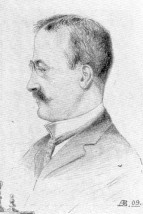 1921):
1921):When contacting us by e-mail, correspondents are asked to include their name and full postal address and, when providing information, to quote exact book and magazine sources. The word ‘chess’ needs to appear in the subject-line or in the message itself.
| First column | << previous | Archives [2] | next >> | Current column |
Blindfold games by Mieses are not particularly common, and the
one below is taken from pages 35-36 of Schachjahrbuch 1920
by L. Bachmann (Ansbach, 1921):
1921):
Jacques Mieses – Taubenblatt
Nuremberg, 2 November 1920
French Defence
1 e4 e6 2 d4 d5 3 Nc3 Nf6 4 Bg5 Be7 5 Bxf6 Bxf6 6 e5 Be7 7 Qg4 g6 8 h4 h5 9 Qg3 c5 10 Nf3 Nc6 11 Bb5 a6 12 Bxc6+ bxc6 13 dxc5 Bxc5 14 O-O a5 15 Rad1 Ba6 16 Rfe1 Rb8 17 Ne4 Qb6 18 Nxc5 Qxc5 19 Nd4 Rxb2
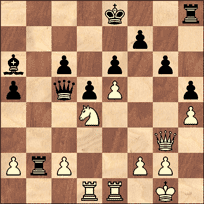
20 Nxe6 fxe6 21 Qxg6+ Kd7 22 Qg7+ Qe7 23 Qxh8 Rxc2 24 Qb8 Qxh4 25 Qd6+ Kc8 26 Qxe6+ Kb7 27 Rb1+ Bb5 28 Rxb5+ cxb5 29 Qxd5+ Kc7 30 Qd6+ Kb7 31 Qd7+ Kb6 32 Qf5 Rxa2 33 e6 Qe7 34 Qf7 Resigns.
It has yet to be established whether the game was one of several
played simultaneously.
Before I Knew Hitler goes back on the shelf we mention for the record another reference to chess in Kurt Lüdecke’s memoirs. Pages 454-455 relate an episode from 1932 when he ‘visited Hitler in his luxurious, modern flat of eight or nine beautiful, large rooms covering the entire second floor of 16 Prinzregentenplatz, in one of the better sections of the outer city [of Munich]’:
‘With visible pride, Hitler conducted me to his library, an attractive, cosy room, lined with several thousand books, many of them gifts, ranged in built-in bookshelves. I was delighted when, leading me straight to a section filled with atlases, geographies and travel books, he pointed out the inscribed copy of Ashwell’s World Routes that I had sent him from New York. “I’m told this is a very fine job of editing. However did you do it? I wouldn’t have credited you with the patience to deal with so much detail.” He waved me on into his study, a room which, despite its simple and practical furnishings, somehow reminded me of a college boy’s study fitted out by rich parents.
“Perhaps playing chess and those months in jail taught me to be patient when I must”, I replied.’
We wonder whether readers have any information about possible connections between chess and Paul von Hindenburg (1847-1934). At present, we can offer only the following, from page 310 of the July 1915 Chess Amateur:
‘General von Hindenburg, now one of Germany’s beloved idols, was, before the war commenced, a most unpopular man, disagreeable in disposition, selfish to the extreme, even for the Prussian military caste, and but little known to the Teutonic populace. One of his hobbies was chess, and he was often to be seen sitting outside a third-rate Berlin restaurant playing the game with acquaintances, surrounded by several dogs. Can it be that the strategy he thus cultivated over the board accounted for what measure of success he may or may not have attained over the Russians? Be that as it may, the struggle in the East is destined to end by an overwhelming defeat of this stubborn old German General.’
The ‘Steinitz Stuck’ composition was given on page 10 of A Chess Omnibus:
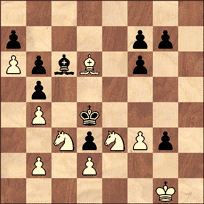
Mate in four. We reported (on the basis of Sam Loyd and His Chess Problems by Alain C. White) that after half an hour’s thought Steinitz offered the solution 1 f4 any 2 Bf8 any 3 Bxg7 any 4 Bxf6 mate. Loyd then pointed out 1 f4 Bh1 2 Bf8 g2 3 Bxg7 stalemate. Consequently, said Loyd, the solution was 1 f4 any 2 b3 (our computer check showed that 2 Bb8 was also possible) g6 3 Be7, etc. Now John Hilbert (Amherst, NY, USA) reports that the original publication was in Mirror of American Sports of 10 October 1885 (and not ‘November 1885’, as stated by A.C. White’s book and followed by us in A Chess Omnibus) and that the solution appeared in the 28 November 1885 issue (mentioning the 2 Bb8 dual continuation). What has not yet been found is a contemporary source for the different version of the composition on page 197 of The Puzzle King edited by S. Pickard (Dallas, 1996): 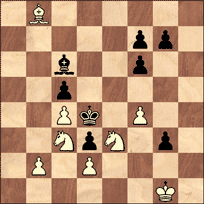
Mate in four. This has two possible key moves, 1 Bd6 (given by Pickard’s book) and 1 Bc7. |
Samuel Loyd |
C.N. 3318 presented a set of stamps issued by Kyrgyzstan in 2000 and remarked that, instead of 1892-1946, Alekhine’s dates were given as 1876-1956 (i.e. the birth-year and death-year of his last wife).
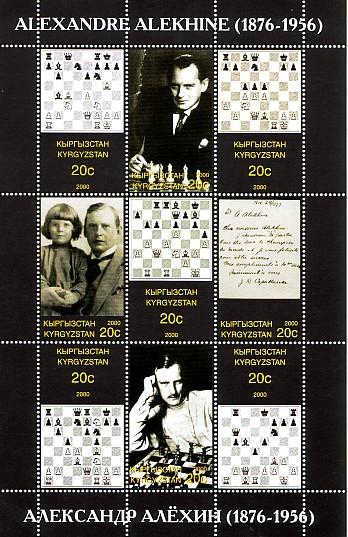
Christian Sánchez (Rosario, Argentina) suggests that the mix-up occurred because these latter dates also appear (although not visibly in our photograph) on Alekhine’s tombstone in the Montparnasse Cemetery, Paris.
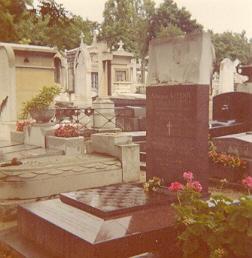
A book prize is offered to the reader who sends (by Friday, 12 November 2004) the best set of replies to the five questions below. As no-one will probably know all the answers, readers are invited, where necessary, to guess freely, secure in the knowledge that when the answers are announced there will be no naming and shaming.
1. Identify the player discussed in the quote below, which comes from a book published in 1880:
‘And certainly *** was in 1851 entitled to the championship not only of all England but of the whole world.’
2. Who are the two players in the photograph below?
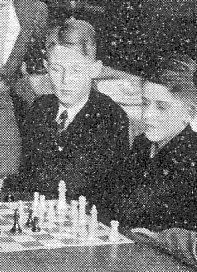
3. Name the player of whom Samuel Loyd wrote the following in 1877:
‘Perhaps *** was the most successful giver of odds that ever lived.’
4. On pages 350-351 of the August 1975 BCM W.H. Cozens asked a question about a published assertion that Jacques Mieses was Australian. Was the answer to his question yes or no?
5. Who is this player?
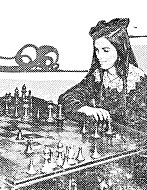
John McCrary (West Columbia, SC, USA) draws our attention to his article ‘The Evolution of Special Draw Rules’ on pages 26-27 of the November 2004 Chess Life, with particular reference to his theory about the ‘triple-occurrence draw rule’:
‘My theory is that it was created during the course of the London 1883 International Tournament.The rules for London 1883 included the following: “The Chess rules adopted for the Tournament are the International Code as laid down in the last edition of the German Handbook, with the addition that if a series of moves be repeated three times the opponent can claim a draw.”
This is not the same as the modern triple occurrence rule, because it refers to a repeated “series of moves”, not to positions. But it introduced the idea of three times being sufficient to claim a draw. Earlier suggestions of a repetition rule had not specified the number of repetitions.
The rule, however, was ambiguous. The meaning of a “series of moves” depends on the position; the same moves may have totally different effects if they are made in positions that differ only slightly.
Thus, after the tournament the rule was perfected by giving it the following wording: “If the same position occurs thrice during a game, it being on each occasion the turn for the same player to move, the game is drawn.” That is essentially the modern rule, since it refers to positions, not to moves. It also does not require that the positions be consecutive. The tournament book of London 1883 suggests that the perfected wording be used in future events.
Thus, one can see the creation of the triple occurrence rule at London 1883. The tournament had a rule, not found in previous codes, about repeating a “series of moves” three times. That rule was too vague, a sub-committee of the tournament defined the idea more precisely as part of a proposed new code, published with the tournament book for use in future international events. And that became the basis of our modern rule.
Why was the triple-occurrence rule created? It may have to do with chess clocks and time limits. That same London 1883 tournament pioneered a new type of chess clock with two clocks joined together in a single apparatus, as they are today. London 1883 also provided that the player exceeding his time limit forfeited the game. That rule was a relative novelty, as previously players were often only fined, not forfeited. In fact, time limits did not exist before the 1860s, and sandglasses were first used for timing the games before clocks were adapted for that purpose.
So the triple-occurrence draw rule may have been created partly because of concerns that a player might repeat moves to avoid time forfeits ...’
We have reviewed various texts up to the time of London, 1883. Many were airily drafted. For example, on page 21 of The Chess-Player’s Handbook Staunton stated that a game is drawn ‘where both parties persist in repeating the same move from fear of each other’, while on page 7 of Chess Praxis (London, 1860) he affirmed that a draw might result from ‘repetition of the same moves or the same line of play on either side’.
The first instance we have found of the number of repetitions being specified is in the ‘Schach-Ordnung’ on pages 345-353 of the September 1858 Deutsche Schachzeitung. Paragraph 39 on page 350 reads as follows:
‘Vorsätzliche Wiederholung derselben Reihe von Zügen führt zum Remis, und zwei Mal erfolgte Wiederholung berechtigt ohne Weiteres zu diesem Schlusse. Als besondere Art gilt das ewige Schach, échec éternel.’ (English translation: ‘Intentional repetition of the same series of moves results in a draw, and twofold repetition automatically legitimates that conclusion. A special type thereof is perpetual check, échec éternel.’)
Vague old rules of this kind may be regarded as nirvana for nitpickers. It should, though, be noted that if ‘twofold repetition’ means, as logically it should, threefold occurrence, the above text excludes a game such as 1 Nf3 Nf6 2 Ng1 Ng8 3 Nf3 Nf6 4 Ng1 Ng8, which is an example of the shortest such draw possible under today’s laws.
Just received: an 877-page hardback Siegbert Tarrasch Leben und Werk by Wolfgang Kamm (published by Manuel Fruth, Unterhaching, Germany). Its most impressive features are detailed research and extensive documentation, i.e. serious, academic treatment of the kind few chess masters have been accorded. With Mr Fruth’s permission we reproduce here, from page 54, one of the many photographs that were new to us: Tarrasch at the age of 18 (Berlin, 1880).
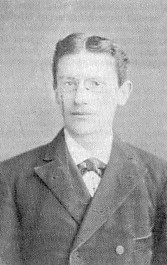
Michael Negele (Wuppertal, Germany) raises the subject of the following photograph in The Steinitz Papers by Kurt Landsberger (Jefferson, 2002):
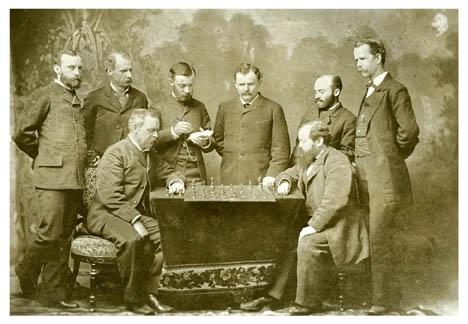
The caption in the book reads ‘Zukertort (third from left) taking notes as Steinitz (seated at right) plays an unidentified opponent, in a seemingly staged photograph, date unknown’. The picture comes from Mr Landsberger’s private collection and is reproduced here with his permission. We invite readers’ suggestions as to who is who.
For a larger version of the illustration, click here.
The winner of the book prize is Birger Flindtholt (Randers, Denmark). The questions were tough, but with one exception (question 3) all were answered correctly by at least one entrant. Below are the answers and a few additional comments.
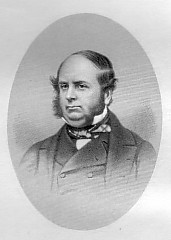
1. H.T. Buckle. The quote came from pages 61-62 of volume one of The Life and Writings of Henry Thomas Buckle by A.H. Huth (London, 1880). The complete text is:
‘And certainly Buckle was in 1851 entitled to the championship not only of all England but of the whole world. Such a case has probably never occurred before of an amateur who was so thoroughly an amateur as only to play for his amusement, and devote no time to the mere study of the game, obtaining so great a victory.’
On page 333 of the July 1891 BCM Charles Tomlinson cited this 1851 championship claim as one of the ‘outrageous statements’ by Huth, ‘the too partial and too sanguine biographer’.
2. Klaus Junge and Wolfgang Unzicker. The illustration was extracted from a photograph (‘New hopes in German chess’) on page 259 of Deutsche Schachblätter, 1 September 1939:
From left to right are Willi Schlage, Karl Krbavac, Edith Keller, Klaus Junge, Wolfgang Unzicker and Rudolf Kunath. The same issue of the German magazine (pages 260-261) gave a game won by Unzicker against Junge, as well as a position from a further encounter in which Junge took revenge. Both may also be found on pages 19-21 of Das Leben und Schaffen von Klaus Junge 1924-1945 by H. Riedl (Unterhaching, 1995).
3. Howard Staunton. On page 1470 of the Scientific American Supplement, 6 October 1877 Samuel Loyd wrote:
‘Perhaps Mr Staunton was the most successful giver of odds that ever lived, and we find that he won some most remarkable games and matches at considerable odds against the most skillful players of his day. He took such pleasure in games of this kind that during the last years of his life he very seldom, if ever, played on even terms.’
4. No. On pages 350-351 of the August 1975 BCM W.H. Cozens, who was reviewing King, Queen and Knight by N. Knight and W. Guy (London, 1975), wrote: ‘And did R.N.W. Blake really write, in The Life and Times of Andrew Bonar Law, “... Jacques Mieses, an Australian master”?’ This was a reference to page 86 of King, Queen and Knight, which misquoted Robert Blake’s book (page 31). The latter book had described Mieses as ‘an Austrian chess master’, although he was German-born.
5. María Teresa Mora Iturralde. The full photograph is given below:
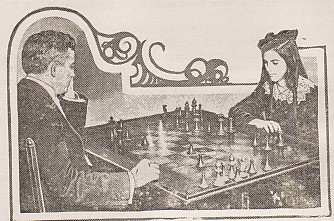
She was in play against Edward Everett (see pages 10-11 of the January 1917 American Chess Bulletin) and was aged nine (and not 12, as stated in the Bulletin). In a letter dated 26 November 1916 Everett wrote:
‘Like many players, I too frequently appraise my opponent by appearances before the game. There was nothing about her to inspire fear. The señorita is a frail, intellectual, little lady with her hair in curls, and the long dress period several seasons away.
After the introduction I patronizingly inquired what odds she would be pleased to accept, and was amused at her declination of the proposal. However, my amusement was soon turned to apprehension when I found myself on the defensive, and to dread when I next realized that my game was lost. She won. Indeed, out of the seven games contested to date, she has won three, drawn three and left me a consolation of the other.’
Page 122 of A Chess Omnibus reported that a very early mention of the girl prodigy was on page 128 of Capablanca-Magazine, 30 September 1914, after she had won a tournament in Havana ahead of Angel Varela and Alfredo Portela. A poor-quality photograph of the three players was published on page 21 of the Cuban magazine Jaque Mate, February 1976.
|
Charles Tomlinson’s comments in C.N. 3464 came from an article entitled ‘Buckle as a Chessplayer’ on pages 328-336 of the July 1891 BCM. A more detailed treatment of the same subject is to be found in Buckle: ritratto inedito di un dilettante by V. Laudi (Brescia, 1994), but what is known of Buckle’s skill, or otherwise, at draughts (checkers)? Page 14 of volume one of The Life and Writings of Henry Thomas Buckle by A.H. Huth (London, 1880) has a diagram with the following narrative:
A footnote gave the solution as ‘White 12 to 16; Black 20 to 11; White 9 to 14; Black 10 to 17, or 18 to 9; when White wins’. |
The chess of Daniel Starbuck (1856-84) was discussed on pages 271-273 of A Chess Omnibus, with a further game in C.N. 2936. Now Neil Brennen (Malvern, PA, USA) sends the following win, from the Pittsburgh Chronicle-Telegraph of 5 March 1884:
‘Cleveland Expert’ – Daniel F.M. Starbuck
Cleveland (date?)
Giuoco Piano
1 e4 e5 2 Nf3 Nc6 3 Bc4 Bc5 4 O-O Nf6 5 c3 d6 6 d4 exd4 7 cxd4 Bb6 8 Bg5 h6 9 Bxf6 Qxf6 10 Bb5 O-O 11 Bxc6 bxc6 12 Nc3 Bg4 13 Kh1 Bxf3 14 gxf3 Bxd4 15 Rc1 Rab8 16 Na4 Bxb2 17 Rxc6 Be5 18 Rg1 Qf4 19 Rg2 d5 20 Nc5 dxe4 21 Nxe4 Rfe8 22 Qe1 Qxf3 ‘winning two pawns clear and a good position’.
Owen Hindle (Cromer, England) reports that the Staunton photograph in C.N. 3451 appeared in the ‘Champions of British Chess’ illustration on page 173 of the October 1898 American Chess Magazine:
For a larger version of the illustration, click here.
Our correspondent also points out that in a feature on page 183 of The Chess Players’ Quarterly Chronicle, 1870 H. Meyer announced:
‘We have in view the publication of a Photographic Chess-board, containing (arranged on the squares) the portraits of 64 English composers. The Carte will be similar to the American Chess-board lately introduced to the chess community by Mr Loyd. ... We may also add a few chessplayers (not known as composers), whose portraits we have ... so as to complete the required number. A subscriber of half a crown will be entitled to a proof copy of the Cartes as soon as they are issued.’
Finally, Mr Hindle sends us a copy of I.O. Howard Taylor’s chess column in the Eastern Daily Press of 2 December 1871, which stated, ‘Mr Henry Meyer, the well-known problematist and chess editor, has brought out a Photographic Chess Board’. The chess personalia listed in the column’s description correspond to those in the above illustration.
A standard-size copy of, for instance, the Staunton portrait remains to be found. As regards the picture of James Leonard in C.N. 3451, Mr Hindle suggests that it may have appeared in Loyd’s American photographic chessboard mentioned in the above extract from The Chess Players’ Quarterly Chronicle. Thus our next question is: can any reader provide a copy of that Loyd item?
Below is a photograph of María Teresa Mora Iturralde which was published (with the board the wrong way round) on page 15 of the Revista Cubana de Ajedrez, September-October 1923:
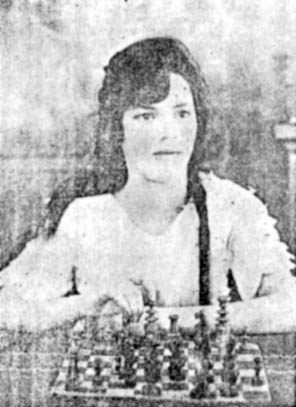
C.N. 3464 indicated that she was aged nine at the time of her encounters with Edward Everett in late 1916, but Tony Stebbings (London) now draws our attention to the following Cuban websites, which state that she was born not in 1907 (as commonly believed) but in 1902:
http://www.lajiribilla.cu/2003/n088_01/088_07.html
http://www.mujeres.cubaweb.cu/articulo.asp?num=107&art=9
In the present item we therefore summarize and assess the evidence. Firstly, all relevant chess reference books known to us say that she was born in 1907. These include Jeremy Gaige’s A Catalog of Chessplayers & Problemists (Philadelphia, 1971) and Chess Personalia (Jefferson, 1987), as well as Le livre d’or de la FIDE (Sutton Coldfield, 1977).
At the start of Chapter IX of My Chess Career (London, 1920) Capablanca wrote:
‘Finally, late in May of 1918 I returned once more to New York. I had not played chess for one and a half years, but an event occurred which undoubtedly will have some influence on my future career. There was in Ha[v]ana a young girl of from 12 to 14 years of age who interested me a great deal. Not only was she intelligent and modest in every respect but, what is more to the point, she played chess quite well (I believe that today she probably is the strongest lady player in the world, though only 15 or 17 years old). I offered to give her a few lessons before I sailed. My offer was accepted, and I decided to teach her something of the openings and the middle-game along general principles and in accordance with certain theories which I had had in my mind for some time but which I had never expounded to anybody. In order to explain and teach my theories I had to study, so it came about that, for the first time in my life, I devoted some time to the working of the openings. I had the great satisfaction of finding that my ideas were, as far as I could see, quite correct.
Thus it happened that I actually learned more myself than my pupil, though I hope that my young lady friend benefited by the dozen or so lessons that I gave her. It came about that I thus strengthened the weakest part of my game, the openings, and that I also was able to prove to my own satisfaction the great value of certain theories which I had evolved in my own mind.’
His pupil was left unidentified in My Chess Career, but he did name her in a letter written in Havana and published in The Times (London) of 20 December 1921 (page 13):
‘I hope the committee [responsible for organizing London, 1922] will also consider a proposition which I have to make with regard to the Women’s Tournament, and that is that in some way they leave open the possibility of the participation in that tournament of the young Cuban girl, Señorita María Teresa Mora. The young lady is only some 17 years old, and yet I believe her to be the equal of any woman player. Her participation would add enormous interest to the tournament and would cost the committee nothing, as I would obtain here the necessary funds for her journey.’
The above quotes indicate that Capablanca believed her to have been born in 1903-05.
The article about her encounter with Edward Everett on pages 10-11 of the January 1917 American Chess Bulletin (see C.N. 3464) referred to ‘a 12-year-old school girl ... who, having obtained her first smattering of chess knowledge at the tender age of eight years, has twice achieved scholastic honors in chess, and developed in the course of four years to such an extent that she is now able to hold her own against experienced players little short of the average first-class in playing strength’.
Edward Everett believed that she was born in or around 1904. In short, none of the above contemporary accounts provides support for either 1902 or 1907.
María Teresa Mora was featured on the back cover of the 10/1974 issue of the Cuban magazine Jaque Mate. No particulars of her birth were given, but the item implied that she was born in or around 1906 (‘Desde muy niña, 10 años, demostró sus condiciones excepcionales como ajedrecista, al quedar en segundo lugar en un torneo escolar de carácter nacional organizado en 1916’). A later Cuban periodical, Boletín Ajedrez (1/1982 issue, pages 38-40), had an obituary by Carlos A. Palacio which was headed ‘María Teresa Mora 1907-1960’. The ‘1960’ was an obvious mistake for 1980 and, indeed, the heading also misspelled Palacio’s own name (‘Palacios’). The final paragraph of the article stated: ‘María Teresa Mora nació en La Habana, el 15 de octubre de 1907 y falleció en la misma capital el 3 de octubre de 1980’.
However, Palacio contradicted himself within the article. He wrote that her victory in the 1914 tournament (referred to in C.N. 3464) was achieved by ‘a girl aged 11’; he quoted unquestioningly Everett’s statement that in (November) 1916 she was aged 12; he stated that when she won the Bohemia Cup in 1919 she was ‘not yet 16 years of age’.
In the second of the Internet articles for which links are provided above, Jesús G. Bayolo reported that during an interview with him in 1976 she specified that she was born on 15 October 1902 and did not know why Palacio had always deducted five years from her age.
We are aware of no grounds for suggesting that María Teresa Mora shared Lady Bracknell’s attitude (‘Indeed, no woman should ever be quite accurate about her age. It looks so calculating.’) and we hope that documentary evidence can be found to confirm the truth. As matters stand, though, it seems perfectly possible, not to say probable, that the many chess reference books which give her year of birth as 1907 are wrong.
From page 184 of Ajedrez en Cuba by Carlos A. Palacio (Havana, 1960):
‘Around 1911 Sir John Dewar, a distinguished member of the British Parliament and a keen sportsman, presented the Havana Chess Club, through one of its founders, Charles M. Echeverría, with a beautiful silver cup to be awarded annually in a tournament and to become the property of any player who won it three times.
These contests were of considerable standing in view of the high quality of the participants. Each winner was tacitly regarded as the champion of Cuba. They were Juan Corzo (1912 and 1918); Baire Benítez (1921); Señorita María Teresa Mora (1922); José Fernández Migoya (1923); Francisco Planas (1927 and 1929) and Rafael Blanco, who took permanent possession of the Dewar Cup by winning it in 1914, 1920 and 1937.’
Sir John Dewar appears to have made no mark as a patron of British chess, and we should like to know why he chose to support the game in Cuba.
Paul Valois (Leeds, England) submits the following offhand game (with a curious, abrupt ending) from the Dewsbury Reporter of 22 November 1902:
George Pollard – Frank James
Marshall
Dewsbury, 8 November 1902
Two Knights’ Defence
1 e4 e5 2 Nf3 Nc6 3 d4 exd4 4 Bc4 Nf6 5 e5 d5 6 Bb5 Nd7 7 O-O Bc5 8 Bg5 Be7 9 Bxe7 Qxe7 10 Nxd4 O-O 11 Bxc6 bxc6 12 f4 Bb7 13 Nd2 Qb4 14 N2f3 c5 15 a3 Qb6 16 Nf5 Kh8 17 Kh1 g6 18 Nh6 Qe6 19 Ng5 Qe7 20 Rf3 d4 21 Rh3 f5 22 c3 Nxe5 23 Qb3 Rad8 24 Qxb7 d3 25 Nxh7
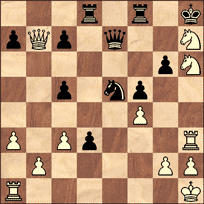
25...d2 26 Qb3 Ng4 27 White resigns.
The newspaper reported:
‘The game, although of a skirmishing character, proved very lively and delighted the onlookers, who thought at one period Mr Pollard was going to pull the game off. Indeed, Mr Marshall afterwards said that the captain [Pollard] had almost made him “wipe the floor” and complimented Mr Pollard on the way he had played the gambit.’
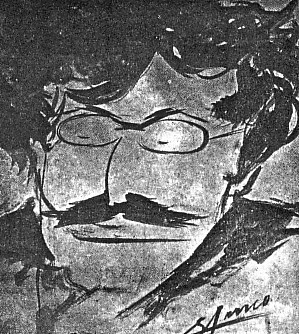
The subject and the artist were both chessplayers, and we wonder whether any reader can identify them.
Under the bland heading ‘Chess in New Orleans’ page 157 of the November 1925 American Chess Bulletin introduced the chess world to one of the most controversial games ever to occur, or not to occur, in over-the-board play: a 23-move brilliancy ‘played between E.Z. Adams and Carlos Torre in New Orleans during 1920’. Torre, who had been in his mid-teens in 1920, provided five notes, including the following after 15...Rc8:
‘But now it was essential to play P-R3. After this move the game is hopelessly lost as White will now demonstrate in a manner that is as masterly as it is pleasing. The coming moves are a study.’
No-one, to our knowledge, has suggested that Torre was using the word ‘study’ in the sense of ‘composition’, i.e. to drop a hint that the game was spurious. Nor do we possess any record of the score having been published anywhere until the Bulletin gave it, after a five-year gap. Above all, has it yet been demonstrated beyond reasonable doubt whether it was a genuine game?
Some aspects of the mystery were discussed on page 339 of A Chess Omnibus, and the present item goes over various other points. First of all, who was Adams, and what was his connection with Torre?
Edwin Ziegler Adams (1885-1944) was described as ‘The Sponsor of Carlos Torre’ in an article on pages 110-111 of the May-June 1927 American Chess Bulletin, which was accompanied by a picture of ‘The Adams Family’:
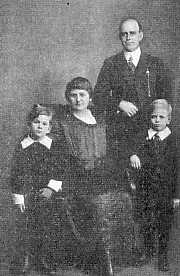
‘On the second page of Carlos Torre’s Development of Chess Ability, reserved for the dedication, appears the name of Edwin Z. Adams of New Orleans quite properly heading the list. We say quite properly because it was due to this Southern gentleman more than to anyone else that the little Mexican, now among the grand-masters of the game, started out upon the great adventure that took him first to New York and then overseas to his European successes. ...
“My chess career”, Mr Adams modestly wrote us many moons ago, “consists principally of my interest in Carlos. I commenced to study the game about ten years ago. I had a hard time of it, as I had to batter my way along and get whatever pointers I could pick up by watching the others play, and finally I learned the code and played over the games in the books. It was over two months before I was able to win a game from the poorest player I could find at the club (and the only one who would play with me), and it was only by “bucking the line” and being “thrown for many losses” and taking my medicine like a man that I finally learned to play a little.
About eight years ago I met Carlos. I think he was then about 14 years old. He was a small, dark-skinned, thin little fellow, very polite, quiet and serious for a boy of his age. He had learned to play chess from his father and brothers and soon was able to make short work of them over the chessboard. Dr Ainsley (now deceased) was their family physician, a member of the chess club and also a very good player, well above the average. When visiting the family one day they mentioned to him that they had a small member who could play a good game and asked him to play with the little chap and see if he really could play well. I think Carlos won two out of the three games to the surprise of all. Dr Ainsley then suggested that he play Mr Percy Moise, a very strong player. Carlos showed his strength with him also. Next, I think, he played with Mr C. Rosen, also one of the best here, with the same results.
Things, however, drifted along until I received a letter from his older brother telling of Carlos’ chess ability, when I arranged to have him come to the club and show what he could do. None of the old dignitaries with chess reputations wanted to play with the child, so a Dr Sternberg, a visitor, volunteered to play him. The latter had been toppling us all over, and that, I figured, would be a real test. I will never forget that day. As one of the gentlemen remarked, ‘You felt more like petting the little fellow than trying to beat him a game of chess’. Carlos electrified the crowd, and Dr Sternberg enjoyed his rout also.
Next, Carlos gave a peripatetic exhibition, playing six games at once, winning four and drawing two. The chess club was so impressed with his play that they gave him carte blanche, and from that time on he visited the rooms very often, until he could not get anyone to play with him, for they were all tired of being beaten. So he had nothing to do but come to my home occasionally, when we would play a few games and go over the openings together. His next feat was to win the city championship in 1923, which he did with ease.
During all these years he worked and attended night school, so he was driven very hard. After a very severe case of pneumonia he was out of a position, and I suggested that he go to New York, with an introduction to the American Chess Bulletin. He also took an interest in problems and endgames and, of course, was excellent in these branches. He won several prizes in Good Companion tourneys. This is about all I can give you concerning Carlos. To you, better than to anyone else, is known the rest.” ’
Further information is provided by a letter in our collection (see also C.N. 1366) which Adams wrote to Hermann Helms, the editor of the Bulletin, on 22 November 1920:
‘Dear Sir:-
I beg to acknowledge receipt of your interesting letter of 18 November and notice what you have to say in regard to everybody being wild about Rzeschewski and that nobody seems to be very much bothered about Capablanca at present. Such is life in a big city, as one new star appears the old one eventually becomes dim.
Of course the match with Dr Lasker and Capablanca would be interesting and I would like to see it come off but as long as it [sic] a commercial proposition the only benefit it would give chess is to give it a few cut and dry games and probably a large number of them draws. It looks like these big fellows want to squeeze the apple for all that is in it.
I have just received a visit from C. Torre, R., and I have obtained the following information from him. He was born in Merida, Yuc. Mex. 29 November 1904 and came with his parents to this country in 1916. He has been playing chess with his father and brothers for about six years and about two years with all comers. He learned the game from his father and brothers and became so efficient at it that he soon left them far behind. He has played the following with the strongest players to a finish in N.O. but I am sorry to say there is [sic] no records kept of the games.
James McDonnell 2 games, he won 1 and lost 1 Prof. Dixon 8 games, he won 5 and lost 3 Chas. Rosen 4 games, he won 2 and lost 1, draw 1 Percy Moise 5 games, he won 4 and lost 1 His simultaneous exhibition at the chessclub, he won eight and drew two games. In a lightning game with Mr E. Laker [sic] of Chicago played in April 1920 the game was given up as a draw.
The little fellow is very modest and unassuming and his success in chess has not given him the swell head. He has a very extensive knowledge of the openings also the end games. He is also a very good problem solver. If he had some professionals to play with, I think in a short time he would be very strong.
I am sending you herewith a copy of the only game that he could give me and hope you will find it of interest.
Awaiting your further kind favors, I beg to remain
Yours very truly,
EZA
The photograph C. Torre brought me was a post card photograph not fit to make a plate from so I would advise if you want a picture to ask brother Magee to loan you the one I sent him which will make you a very good cut.’
The two-page letter may be viewed here (page 1, page 2). We have no information on a draw against ‘Mr E. Laker of Chicago’ in 1920, but page 203 of the December 1921 American Chess Bulletin gave a loss by the Mexican (‘played between Carlos Torres [sic], 16 years old, and Edward Lasker of Chicago during the latter’s visit to New Orleans during November’).
C.N. 1366 quoted Dale Brandreth’s opinion on the above document:
‘This letter is very significant because it drives the final nail in the coffin of one of the most famous games of all time, a game that simply never was. ... It seems obvious that the game could not have been played up to 22 November of that year without Adams mentioning it or sending it to Helms, so except for the faint possibility that it was played from 23 November to 31 December of 1920 – and then surely Adams would have sent it to Helms at that later date – there simply was no such remarkable game played until that time. When Torre sent the game to Helms in 1925, it was simply his reconstruction of the “game” including the post mortem analysis that comprised the beautiful final combination. The game actually sent to Helms, referred to in this letter, could not have been the game since it was so sensational that Helms would have immediately published it.
... I also learned on excellent authority from Mexican contacts that Torre admitted to Mexican friends that the “game” was really post mortem analysis from a position reached in a skittles game in which after the game Torre showed Adams how he could have won brilliantly. Torre’s statement was that it was not so important who had won or the authenticity of the record, only that it was a beautiful game.’
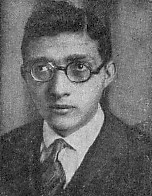
Carlos Torre
The matter was also discussed on pages 22-23 of Vida y Partidas de Carlos Torre by G. Velasco (Mexico, 1993) and page 287 of the English edition, The Life and Games of Carlos Torre (Milford, 2000). From the latter volume:
‘While some authors (e.g. Fine in The World’s Great Chess Games, 1951, or Nigel Davies in The Power Chess Program, 1998) have presented this as an actual, serious encounter, there is strong, almost conclusive evidence that it was not. The author once casually queried Torre on it. After 57 years he could not quite recall the details, but what he said implied that from his viewpoint it really didn’t matter if it had been a skittles game or post-mortem analysis, so long as the combination was extremely original and beautiful. Torre’s friends, the late Alejandro Báez, and Pedro Busto Undiano, still living in Mexico City at this writing, knew him well when his memory was more reliable. Both of them assured this writer that the game in fact was never played; rather the whole idea had occurred to Torre after analyzing a skittles game. They said that Torre could find no better way to make the beautiful possibilities he saw known to the public than by inventing a game, so he decided to pretend he had lost it to his teacher Edward [sic – Edwin] Adams, for whom he had great affection.’
And what of Adams? We are aware of only one public comment by him on the Torre game. After Irving Chernev had published it on page 20 of the January 1943 Chess Review (‘This game ranks with the most brilliant ever produced in the whole history of chess.’) Adams, as reported in C.N. 1432, reacted in a letter to the editor on page 146 of the May 1943 issue:
‘Allow me to thank you for the very complimentary remarks in Chess Review (January 1943) on my game with my little Mexican friend Carlos Torre.
Three of my sons are now in service of their Country and I would like to have you send each of them a copy of your January issue, so that they can show the game to their friends and say “That’s my Pop.”
E.Z. Adams
New Orleans, La.’
Adams died the following year. (The death notice in the New Orleans States newspaper, 20 May 1944 named the sons in question as ‘Edwin Z. Jr, USNR, Captain Gerard C., US Army Cadet, Joseph T., USMA’.)
Our preference, as usual, has been to present the documentary evidence neutrally and to leave readers to draw their own conclusions, or to conclude that drawing conclusions would be premature. So far, no correspondent has taken up a point raised in C.N. 2227, which quoted the following paragraph from page 156 of the American Chess Bulletin, July-August 1921:
‘New Orleans, however, is not wholly without its chess organ, for a department is regularly devoted to chess in the pages of The Morning Star, a Catholic publication. E.Z. Adams is the chess editor.’
What appeared in Adams’ column about Torre, and possibly also about the Adams v Torre game?
From Tim Bogan (Chicago, IL, USA):
‘I have come across two claims of chess played at high speed which seem exaggerated to me. Firstly, Alexander Kotov writes on page 32 of The Art of the Middle Game (Harmondsworth, 1964):
“When I stayed behind at school with my school friends after lessons, and managed to play up to a hundred games in a single afternoon...”
If we define “afternoon” generously as noon until 6 p.m. the time-limit would have to be 1.8 minutes, i.e. each player is allowed 108 seconds to make all his moves (6 hours x 60 minutes = 360 minutes / 100 games = 3.6 minutes per game for both players). This leaves no time to set up the pieces, set the clock, etc., but I have seen young players of speed chess complete all their moves within one minute, so it is barely possible.
Reuben Fine, however, takes us to a new level. He writes on page 61 of Chess Marches On! (New York, 1945):
“Naturally, tournament chess requires several hours, sometimes as many as eight or ten, for the completion of a single game; so does baseball, and football, and golf. But chess at lightning speed is also a possibility – experts in offhand moments can finish 50 or 100 games an hour if they are so minded.”
Fifty games in one hour would require a time-limit of 36 seconds for a player for the entire game (60 minutes / 50 games = 1.2 minutes per game for both players). A hundred games in an hour would necessitate a time-limit of 18 seconds for a player to complete all his moves. While it is possible to play such games, it seems certain that each would be prematurely ended by a player exceeding the time-limit in a position where his pieces were hardly developed. They could not be “games” in the commonly understood sense.
Are there other exaggerations of chess speed?’
The reference to golf in the preceding item prompts us to offer a few jottings on the (rare) connections between the two games. First, there is a well-known photograph of Emanuel Lasker in action at Nottingham, 1936 (watched by, among others, B.H. Wood and Vera Menchik):
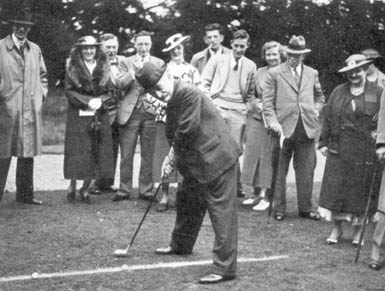
The following passage about Capablanca by William L. Hughes of Cleveland comes from page 77 of the May-June 1926 American Chess Bulletin:
‘He also had a peep at the mysteries of golf, and while not yet an “addict” it is my opinion that he will shortly succumb to the lure of this fascinating sport. He is fond of tennis and gave Mr Elliott E. Stearns a lesson in this game. Also there is just about as much chance of winning from him at auction bridge as there is at chess.’
Then there is Purdy’s well-known quote ‘Pawn endings are to chess what putting is to golf’, often repeated (e.g. on page 280 of Chernev’s The Chess Companion) without any source being specified. We therefore point out that the following appeared on page 71 of Guide to Good Chess by C.J.S. Purdy (Sydney, 1950):
‘Pawn endings are to chess what putting is to golf, with the big difference that they do not occur in every game. They occur just often enough to make them well worth while studying, and they have a fascination all their own.’
|
The subject was Emanuel Lasker and the artist Rafael Blanco. The portrait appeared on the front cover of the Cuban magazine Crónica de Ajedrez, June 1911. Blanco is probably best known in the chess world for his loss to Capablanca at Havana, 1913 (annotated in Chess Fundamentals). The biographical feature about him on the back cover of the 9/1974 issue of Jaque Mate (Cuba) described him as ‘an exceptional caricaturist, a graduate of the Escuela de San Alejandro in Havana’. |
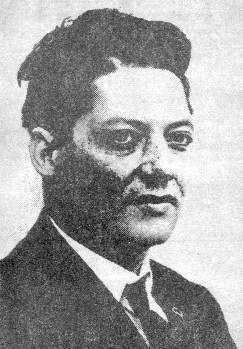 |
Also from the June 1911 issue of Crónica de Ajedrez (page 66) comes this caricature of Capablanca by Conrado Massaguer:
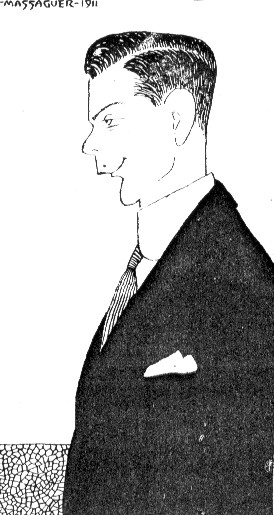
The second link provided in C.N. 3468 is currently not working, and we therefore give below, for the record, the relevant text from Jesús G. Bayolo’s article:
‘Es oportuno hacer una aclaración: en los muchísimos artículos que escribió sobre ella Carlos A. Palacio, el principal historiador que ha tenido el ajedrez cubano, aparece que María Teresa nació en 1907, lo cual – sin culpa alguna – han amplificado quienes bebieron en esas Fuentes.
No pudo haber ganado con siete años el primado de los torneos infantiles, porque aprendió el ajedrez a los 10 años, enseñada por su padre y por su hermano. Cuando la entrevisté, el nueve de agosto de 1976, me dijo en tono dulce, tal como era: “No sé por qué Palacio siempre me pone cinco años de menos. Por él voy a demorar mucho en llegar a los 100 años...” y sonrió como si hubiera hecho una travesura.’
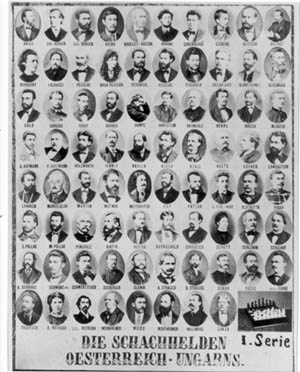
This composite photograph in our collection (click here for a larger version) includes rare portraits of Berger, Gelbfuhs, Hamppe, Meitner and Trebitsch.
C.N. 1426 gave a game of Marseillais (double-move) chess won by Alekhine against Albert Fortis. Below is another specimen, culled from page 87 of La Stratégie, April 1925:
Campbell and I. Rossow – Robert Crépeaux
Occasion?
1 Nf3/Nc3 b5/Bb7 2 b4/e4 g5/Bg7 3 Bc4/Nxg5 Bd5/Bxc4 4 d3/Bf4 h6/hxg5 5 Bxc7/Bxd8 Bxd3/Bc4 6 Qc1/Kd2 Be5/Bf4+ 7 White resigns.
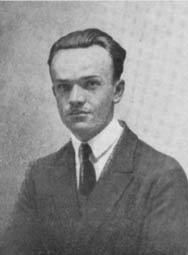
For further information on Marseillais chess, see pages 187-190 of D.B. Pritchard’s excellent volume The Encyclopedia of Chess Variants (Godalming, 1994).
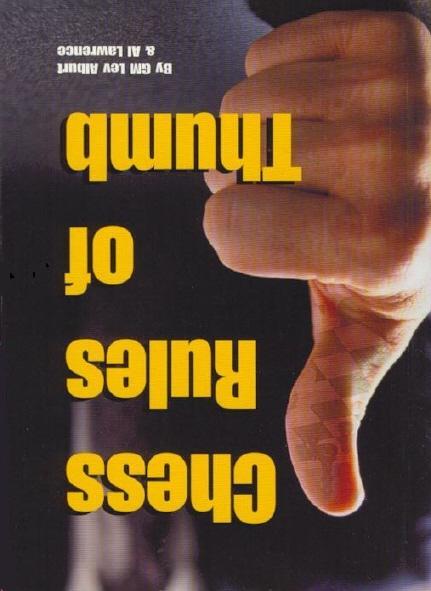
From the Preface (page v) to America’s Chess Heritage by W. Korn (New York, 1978):
‘While many opinions in this book might be my own responsibility, I have tried my utmost to verify and review the facts, statements, documents, and relevant writings as referred to; to rectify erroneous beliefs; explode myths; and provide a complete record of any essential American national chess data.’
As early as page 4 the book refers to ‘William Staunton’, with several other obvious errors in that first brief chapter (such as, on page 7, 1875 instead of 1857 as the year of the New York tournament won by Morphy). A passage on page 110 is baffling:
‘The Spaniard Pablo Morán, in Agonía de un Genio, A. Alekhine (Madrid: Edit. Aguileras [sic], 1972), page 55, hints at Capablanca’s family having left Spain for Cuba – shortly after its discovery by Columbus in 1492 – due to the expulsion of Sephardic Jews from Spain, and the latest persecution there of baptized Jewish “Marranos”. Morán thus emphasizes the ongoing contribution to chess by players of Spanish cultural heritage, regardless of past ideologies.’
We cannot imagine how Korn derived any such understanding from Morán’s book, which merely contained (in a footnote) the following text:
‘Steinitz y Lasker fueron también de origen semita. En cuanto a Capablanca, cubano de origen español, tal vez tuviese alguna gota de sangre judía, como la tenemos todos los españoles, ya que cuando fueron expulsados de nuestra patria en el siglo XV fueron muchos los que se quedaron y mezclaron con el pueblo.’ [English translation: ‘Steinitz and Lasker were also of Semitic origin. As regards Capablanca, a Cuban of Spanish origin, perhaps he had a drop of Jewish blood, as all we Spaniards have, given that when they [i.e. the Jews] were expelled from our country in the fifteenth century many remained and mixed with the people.’]
Chess Notes Archives:
| First column | << previous | Archives [2] | next >> | Current column |
Copyright 2004 Edward Winter. All rights reserved.